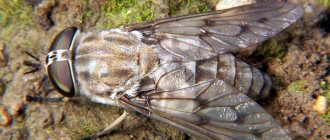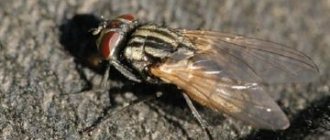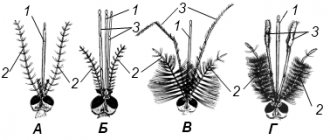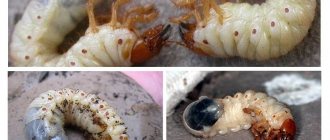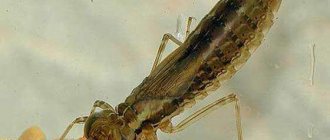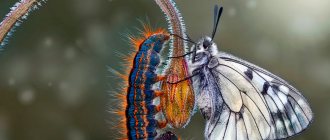Description and features
The two-winged insect with short antennae belongs to the Tachi-nidae family. Large hemispheres of eyes with a multi-colored iridescence on a shaggy body up to 17 mm long, transparent wings of the fly make up the external appearance. The species Dermatobia hominis, which is dangerous to humans, lives in Central America. It is capable of attacking and laying its eggs under the skin.
Many have seen these large flies with bright colors in the countryside, in nature or fishing. Externally, the gadfly in the photo is very similar to the two-winged horsefly; they are often confused with each other. Their habitat is the same. The bite of a horsefly is dictated by hunger; it is a blood-sucking insect. The main difference is nutrition. A gadfly, like a horsefly , can bite, but only for the purpose of reproduction.
In some regions the insect is known as spiderweed. Many species of dipterous flies that parasitize large mammals are collectively called gadflies. Common features for insects:
- gadfly dimensions 15-20 mm;
- the mouth is absent or reduced;
- body with villi;
- huge eyes;
- oval body;
- the front legs are shorter than the hind legs;
- almost transparent mesh wings.
The body color is very different. For northern latitudes it is of calmer tones:
- brown;
- dark gray;
- different shades of blue.
In the south and tropics, the insect closely resembles small bumblebees with orange and black stripes. It is believed that the gadfly's flight speed of 120-140 km/h is comparable to that of a dragonfly.
2. The family to which the gadfly belongs is called Tachi-nidae in Latin. There are many species of this parasite on the planet, but they all have common features.
3. Gadflies live on all continents except Antarctica. 150 of their species studied by scientists settle near livestock farms or in places where their hosts—animals—congregate: in meadows and pastures, near watering places.
Large human gadfly
4. Only one species - the great human gadfly from South America - deliberately attacks people.
5. The gadfly is a biting insect. Many people confuse it with horsefly, but they are not the same insect. Horseflies are bloodsuckers, and gadflies are insects that do not suck blood. It only bites and parasitizes animals, and even humans.
6. Gadflies are also flies with dim colors of various shades and sizes from 13 to 20 millimeters in length, depending on the species. Like all other flies, they have large compound eyes and small transparent wings. The gadfly insect is very similar to an ordinary fly, however, it is very different from this unpleasant human neighbor. Both the size of the body and the amount of harm caused.
7. The gadfly has a short mustache and large, expressive eyes that shimmer in different colors in the sun. The length of the body of the gadfly reaches 20 millimeters. The body is covered with villi - short, hard, dense and often brightly colored.
8. The insect’s head is shaped like a hemisphere. Well developed. The wings are light, transparent, dotted with small veins and wrinkles - just like those of a fly. The hind legs are slightly longer than the front legs.
9. In addition to how painful it is to bite, gadflies can lay a clutch of eggs on the skin of the chosen victim - animal or human. The bite of a gadfly in comparison with this is not so terrible.
10. But when, after some time, larvae appear from the laid eggs, this is where the real horror begins. The larvae gnaw small holes in the skin and penetrate the human or animal body. And this causes the development of certain diseases.
11.But the gadfly is far from a stupid insect! Of the several dozen different species of these insects, only some use humans as an incubator; the rest prefer to use animals for these purposes.
12. Why does this happen? Yes, because gadflies understand perfectly well that a person will eventually find the larvae and eradicate them from the body, which cannot be said about the animals on which such “smart” species of gadflies fly.
13. Gadflies are not just one species, but a collective name for all dipterans that, one way or another, use warm-blooded animals to carry their eggs.
14. Depending on which part of the body their larvae live, gadflies are divided into types. The most common of them: gastric, abdominal, skin.
15. Skin and gastric botflies are insects with a complete cycle of transformation, and cavitary botflies - with an incomplete one.
Gastric gadfly
16. Gastric botfly is an insect that “practices” on the digestive organs of an animal or human. The female tries to lay eggs in such a way that they are sure to get into the stomach along with food, where the conditions for the development of the young generation are most favorable.
17. One of the representatives of gastric insects is the horse gadfly.
18. Gadflies are also divided into types based on who exactly is their “favorite” - horse, deer, cow, sheep, human or someone else.
19. There are also types of gadflies that are generalists; they absolutely do not care at the expense of whom to parasitize.
20. Gadfly is a fairly common insect in Russia. Its territory is home to 6 species of this dangerous dipteran.
21. The usual habitat of the gadfly is the banks of natural reservoirs, as well as forests and steppes.
Skin gadfly
22. Skin gadflies. The most famous of them is the bovine gadfly, the female of which attaches eggs to the hairs of the animal, and the hatched larva pierces the skin of the animal and lives there until pupation.
23. The female skin gadfly tries to glue eggs to the hair on the legs of a cow or bull. It is from this place that the path of the hatched larva begins, first to the esophagus, and then to the spinal muscles.
Gadfly
24. Cavity botflies are parasites, specifically the so-called sheep botflies, that lay eggs in the nostrils, eyes or ears. They differ from other families of gadflies in that they have an incomplete transformation cycle.
25. The gadfly is a viviparous insect. The female cavitary botfly lays live larvae in the cavities of animals and humans. She “squirts” ready-made larvae, trying to get into the animal’s mouth or nose. Often this gadfly parasitizes the eyes, including those of humans.
26. Mating of adults occurs soon after birth. Depending on the region, these may be different months of the year. Especially if it is quite humid and warm at this time. It is considered optimal when the surface body temperature of the animal is at thirty degrees Celsius.
27. In total, an adult insect can live for a maximum of a month, and the usual period before mating is only three days. Gadflies can fly immediately after the adult emerges from the pupa.
28.Each of the females of this parasite is capable of laying up to seven hundred eggs on the body of one animal. Moreover, depending on the species, the location of oviposition varies greatly. But basically the principle of its location is the same - a small awn and a thick undercoat.
Reproduction and development of gadflies
29. Therefore, the places of clutches on the animal’s body are most often the following: groin; stomach; front of thighs. Only then, having penetrated under the skin, the larva moves along the vessels or nerve endings to the dorsal part of the host.
30. Gadfly is an insect that has a closed chain of transformations. In the full cycle of its development (with rare exceptions), it passes from the egg to the adult state (imago), passing between the forms of first a larva, then a pupa. It takes the gadfly about a year to do everything.
31. At the first stage of the life cycle, the female insect lays eggs. Ideally, on the body (or inside the body) of the animal; as a last resort - somewhere in the grass (so that the animal can swallow them along with food).
32. Once in favorable conditions, the eggs become larvae, which quietly mature in the warmth until the right moment, and then fall out of the animal’s body along with feces or exit through the skin.
33.After some time, the larva turns into a pupa, and that, in turn, turns into an adult.
34. A mature insect does not need food. It has enough reserves accumulated by the larva during its “residence” in the animal’s body, and then in the “hypostasis” of the pupa. True, the adult does not live long - only three to four days.
Gadfly larva
35.Her main task is to have time to give birth to offspring, and at this point the “mission” is considered completed. This is the “meaning of life” the gadfly has.
36. The gadfly bites solely for reproduction. Only females bite, trying to lay their eggs at the site of the bite.
37. Often these insects choose certain areas where a large number of females accumulate. Naturally, males also fly here. Typically, such areas are areas where livestock are constantly walking or swampy areas. A person should stay away from them.
38. The transformation of a gadfly into an adult occurs almost instantly, after which the adult gadfly flies off to the mating sites. Some scientists support the assertion that the mating sites of gadflies do not change over several generations, like fish spawning grounds.
39. The duration of the period of activity of gadflies depends on the climatic zone to which a particular area belongs. The longer the summer, the longer this period.
40. In Russia it takes about three months - from June to August. When the botfly insect disappears, it’s time to prepare for the cold weather.
41.The gadfly is most active in dry, hot weather. In the open sun it turns into a real monster, but it doesn’t like cloudy weather.
42. Scientists have long proven that cows subjected to constant attacks by gadflies produce significantly less milk than their luckier “comrades.” Annoying insects irritate animals, cause them tension and prevent them from eating normally - hence the low milk yield.
43. Gadfly bites can cause harm not only to animals, but also to humans. When going out into nature on a hot summer day, you should remember that a dangerous gadfly may be waiting there.
44. This insect’s bite on a person is not so subtle. Usually, when “planning” to attack and approaching the intended victim, this fly buzzes very loudly and obnoxiously. So, in principle, there is a chance to brush it aside.
45. The human gadfly does not contact people directly. This parasite infects blood-sucking insects with eggs, in particular mosquitoes, which, when they bite, carry the eggs of the gadfly under the human skin. Moreover, the cunning larvae use the site of a mosquito bite to penetrate.
46.But not only the large human gadfly “works” through mosquitoes, other species also use this technique. Therefore, a gadfly of another species can also take over the human body.
Trap for harmful insects
47. In order to protect yourself from the attacks of these harmful insects, you need to know some rules: The gadfly is a “stylish” and creative insect! Despite its rather gray appearance, this fly is attracted to very colorful and bright clothing.
48. This is why you need to choose darker shades in your clothes on vacation. These flies just love the sun! In the shade, fortunately, they are not active at all. Therefore, know that you can easily hide from them there. And for relaxation it is advisable to choose less sunny places.
49. But if a bite does occur, you need to immediately take appropriate measures: thoroughly wash the affected area with water (or with soap); to remove dirt, you need to drop a little hydrogen peroxide into the bite site or lubricate the area with brilliant green; If the bite causes severe pain, you can take a painkiller.
50. You can use folk remedies. Plantain will relieve unpleasant itching. You need to prepare a paste from its leaves and apply it to the bite site, securing it with a bandage. Dandelion juice also copes well with this task. You need exactly white (milky) juice. It can be obtained by cutting a flowering shoot or the dandelion leaf itself. You can use onions: soak the bite site with its juice, and then apply a bandage. If it doesn’t help, see a doctor immediately!
photo from the Internet
Kinds
The family Nu-podermatidae includes insects in which the larva develops in the nodules under the skin of animals. They parasitize many mammals. Among them:
- Small rodents. Here development takes a little time. The female lays eggs on the fur. The larvae that emerge from them burrow under the skin. There is no migration.
- Large mammals. After laying on the hair, the larvae that emerge from the eggs begin migrating to the back of the animal. Their path of movement goes along the subcutaneous layer, inside the muscles and internal organs. Travel time is from 3 to 9 months.
There are types of gadflies:
- Gasterophilidae – parasites in the stomachs of animals. Flies of medium or large size (9-20 mm). Adults do not need food. They are found in the eastern hemisphere, but equines are common everywhere. The larvae live inside the stomachs of odd-toed ungulates, elephants, and hippopotamuses. The female gadfly lays about 2 thousand eggs on the skin or hair layer near the mouth. Gasterophilus pecorum lays eggs on the grass. The first instar larvae enter the digestive system and live until they grow. They come out naturally (with excrement). Animals infected with parasites develop gastrointestinal pathology.
- Horse (Gasterophilus intestinalis) is one of the common species. Length varies from 13 to 16 mm. The hairs on the body are yellow or brown. The wings are all with dark spots. A noticeable feature is a bright black dot in the radial vein. The insect uses horses and donkeys for its reproduction. In females, the ovipositor is strongly bent under the body. During flight, females lay on the surface of the skin in places where victims can scratch with their teeth. When the larva enters the mouth, it develops for about a month, then passes through the pharynx into the stomach. Their number sometimes reaches hundreds.
- Northern deer (Oedemagena taran-di) - lives off reindeer. Animals travel great distances to winter. There the insects grow, leave the host and move into the ground. With the onset of spring, deer migrate north. Young gadflies must fly many kilometers to again parasitize animals. Natural instinct drives the insects north, they reach the victims and begin to attack defenseless deer. One female can lay up to 650 eggs.
All gadflies are divided according to the type of mouth opening. In Oestridae typicae it is absent or underdeveloped. Representatives of the small Cuterebridae group have a more pronounced proboscis (mouth), without tentacles. Scientists divide the first type into three sections:
- Gastricolae - larvae with two hooks for penetration; there are special tubercles with small spines;
- Cavicolae – two hooks and large spines, the female is viviparous, no ovipositor;
- Cuticolae - there are no hooks, the spines are small, they are almost invisible.
Cattle attack Hypoderma bovis De G. bovine botfly . For horses and donkeys, the equine species has become a threat. Sheep try to escape from the sheep type Oestrus ovis L. Even wild animals have their own varieties:
- American squirrels are attacked by C. emasculator Fitch;
- Elephant intestines are infested with Cobboldia elephantis Brau;
- rhino suffers from Gastrophilus Rhinocerontis Ow.
In the tropics of Central America lives Ver macaque and moyocuil, which can accidentally attack a person. After a gadfly bites and the larva implants, a large tumor, or hardening, with a hole at the top grows. This type affects dogs and livestock.
The photo shows a gadfly larva
Appearance
Not everyone knows what a gadfly looks like. Botflies are insects with one pair of membranous fore wings. The head is semicircular, very mobile, connected to the chest by a thin stalk. There are no mouthparts because adults do not feed. There are 1 pair of compound eyes and 3 simple ocelli on the head. There are short antennae on the forehead. Gadflies have 3 pairs of legs, the hind legs are slightly longer than the front ones. The body is covered with long and short hairs, as well as bristles. These insects live everywhere and mostly near humans. These insects feed on liquid food: blood and other body nutrients. Only larvae feed, and adults lack mouthparts, so it is a misconception that the adult gadfly feeds.
Gadfly photo insect
Lifestyle and habitat
The place of parasitism in gadflies is different, therefore there are 3 types:
- Gastric. Distributed almost everywhere. The female lays eggs on wool, limbs or grass. After penetration inside, the maturation cycle begins. The result is access to the surface of the skin through fistulas or with waste products. All this causes severe itching in the animal. The most common is the horse gadfly .
- Subcutaneous. The habitat of this type is all latitudes except the Far North. It chooses cattle as its victims. The female insect lays eggs on the fur, and the larva penetrates the skin. A focus of inflammation – myiasis – develops. Before molting begins, the parasite enters the subcutaneous layer, forming holes there. There have been recorded cases of it penetrating inside the skull of an animal and the human brain. This resulted in death.
Subcutaneous gadfly, lays larvae when bitten
- Cavity. The main difference from the previous ones is that females give birth to larvae during flight, bypassing the stage of laying eggs. They are able to spray them onto the mucous membranes of the eyes, nostrils of an animal or a person. After which the parasite remains inside the eye, eyelid or nose. Then, by migration, it gets inside - the sinuses, the oral cavity, etc. Severe inflammation develops at the injection site.
The gadfly is most often found on sheep
The human gadfly is not found in Russia, but can be spread by people already infected with parasites. It differs from the others in its penetration mechanism. The female first lays eggs on an insect that can feed on human blood. This is usually a mosquito, tick or other bloodsucker. After a bite, the gadfly larva moves under the skin of the victim, where the life process continues.
The parasite can be found everywhere except the coldest latitudes (Antarctica). mainly lives in warm and temperate climates. In Russia there are many of them in the vastness of Siberia, the Ural and Northern regions. Frequent clusters of insects nearby:
- pastures;
- livestock farms;
- places where animals pass.
Insects love a humid climate, so they swarm in large numbers near rivers, ponds and swamps.
Symptoms and consequences of a gadfly bite
Only one species of gadfly, Dermatobia hominis, which lives in the forests of Central America, uses humans as a “reservoir” for rearing larvae. After a bite, a disease called dermatobiasis develops, manifested in local inflammation, suppuration and the development of general intoxication phenomena. A bite from a human gadfly is rarely fatal. One case of death of a one and a half year old child with multiple infestations, that is, with the penetration of a large number of larvae under the skin, was registered.
More often, the death of children is associated with brain damage when the larvae penetrate inside the skull. In this case, symptoms such as swelling of the upper body, inflammation of the lymph nodes, and headache associated with increased intracranial pressure are observed. Fortunately, such a complication develops extremely rarely after a Dermatobia hominis bite.
In Russia, people become victims of gadflies extremely rarely: such cases occur sporadically, since all species living in our country parasitize farm and wild animals. However, females still lay eggs under the skin of people, so it is important to know the symptoms of infection in order to consult a parasitologist or dermatologist in time.
The larva can appear on any part of the human body, but most often the eggs are laid on the legs, back or armpits. Very rarely, larvae are found in the eyes.
There are no symptoms of infection after a bite. It is almost impossible to feel that a female gadfly has landed on the skin due to the soft legs of the insect, covered with hairs. At the moment of the bite, a burning pain is felt, which quickly passes.
At the site where the eggs were implanted, you may notice a slight swelling, which is practically no different from a mosquito bite. After a few days, inflammation forms at the site of the swelling. It becomes painful, swells, an abscess forms, which after some time opens with the release of pus. This creates a hole through which the growing larva receives the oxygen it needs to breathe. Movement may be felt in the area of inflammation.
In addition to local manifestations, symptoms of general intoxication are noted:
- nausea and vomiting;
- feeling tired, increased fatigue;
- drowsiness;
- increased body temperature;
- pain in muscles and joints.
If the larva is in the eye area, when moving it will constantly irritate the mucous membrane, which will cause pain and discomfort. Intraocular pressure increases. Increased sensitivity to light appears, and lacrimation may occur. If the larva is not detected in time, it may end up in the vitreous body or in the anterior chamber of the eyeball, as a result of which the person may lose the organ of vision.
In rare cases, the larva may end up in the nasal cavity. In this case, the following symptoms are observed:
- headache;
- decreased sense of smell;
- swelling of the nasal mucosa, making breathing difficult.
If the larvae are detected in a timely manner, they are removed surgically. If removed quickly, infection does not pose a danger to the body. However, if you do not get rid of the larva in time, a secondary infection may develop, which can result in a life-threatening complication such as sepsis. Another complication of infection is an allergic reaction, which can vary in severity: from urticaria to anaphylactic shock.
If you suspect an infestation with gadfly larvae, you should consult a doctor. Under no circumstances should you remove the larva yourself. This is due to the fact that in many species the larva has numerous hooks for better fixation in the tissues, which can remain in the wound and cause suppuration.
Gadfly larvae are removed under local anesthesia. The doctor carefully grabs the larva with tweezers and pulls it out. After this, a bandage with an antiseptic is applied to the wound.
The following recommendations will help you avoid a gadfly bite:
- when going into nature, you should not wear bright clothes: they attract not only gadflies, but also blood-sucking insects, for example, horse flies;
- It is important that while walking outside the city, your arms and body are covered with clothes;
- in places where gadflies can be found (near farms, pastures, watering places), perfumes should not be used;
- It is advisable to cover the stroller with a special canopy;
- In nature, it is imperative to use repellents;
- Gadflies are attracted to the smells of feces and rotting. Therefore, toilets and cesspools should be installed as far as possible from the home or tourist stop;
- Gadflies are repelled by the smells of cloves, mint and citrus fruits: to prevent insects from entering the room, you can use aromatic oils.
Nutrition
The parasite larva receives nutrition while inside the victim. Adults cannot absorb food; their oral apparatus is reduced. The pest inside the victim is pear-shaped with the obligatory spines on its scales for advancement. All this is enclosed in a sclerosed capsule, with a hole at the bottom. Length reaches 25 mm, diameter 7 mm.
The basis for nutrition is blood fluid. After securing itself inside the host, the larva begins to accumulate all the useful substances for further existence. The parasite secretes a liquid mass in its body, causing severe pain and inflammation.
What is the danger to humans and animals?
The gadfly is a biting insect ; the gastric and cavitary type is considered the most dangerous for people. After entering the body, the larva begins to actively feed. It deprives him of vital energy, vitamins, and pathological processes begin. Migration throughout the body and internal organs, right up to the brain, causes health problems. Deaths from infection are common.
When the larva gets inside the victim, myiasis begins (the formation of a parasite). More often this happens in the summer. The infection process occurs in stages:
- a female insect attaches eggs to the scalp of a person (usually the head);
- the parasite begins to come to the surface from body heat;
- penetration under the skin or into organs;
- the formation of fistulas for the breathing of parasites, through which they exit.
There is a certain risk group for a person. This category needs to be careful when walking and interacting with livestock. In an area of increased risk of infection:
- advanced age;
- insufficient hygiene;
- mental illnesses;
- craving for alcohol;
- diabetes type 1 and 2;
- diseases that provoke hematopoietic obstruction;
- frequent stays in the tropics and subtropics.
At the slightest sign of infection, you must contact a medical facility. Bodflies are dangerous for animals, they are annoying, and livestock are defenseless from their attacks. The potential victim becomes very nervous and begins to lose weight from poor nutrition.
This reduces milk yield from livestock. Parasitic larvae take useful substances for themselves. A large number of pests weaken animals, they get sick and lose their sight. Migration completes its destructive action after infection. Nerves are damaged, internal bleeding and paralysis begin.
Ixodid tick
Everyone is familiar with this parasite - tick bites annually become a threat to both people and their pets. The dangerous period lasts approximately from mid-spring until autumn. The tick can live in tall grass and bushes in parks, squares, forests and rubble of grass, branches and leaves.
Dogs are most often at risk of tick bites, since domestic cats are less likely to be outdoors. Therefore, it is recommended to examine the dog after each walk. If you find a tick, it is best to seek qualified help. If this is not possible in the near future, then the tick should be carefully removed yourself using tweezers or thread and the wound should be treated with a simple disinfectant.
If the tick was a carrier of diseases, then the first symptoms appear 2-3 weeks after the bite and depend on the specific infection that entered the body. General signs: gastrointestinal upset, lethargy, weakness.
To protect your pet from possible infection, you need to vaccinate your dog in advance - this is the most effective remedy against the serious consequences of a tick bite.
Reproduction and lifespan
An insect goes through a full cycle of transformation: egg, larva, pupa, adult. Life expectancy 1 year. There is one peculiarity: adult gadflies do not receive food. Their existence is possible due to the substances in the body obtained by the larva. The life period completely depends on the temperature and the speed with which the insect creates a “platform” for its offspring.
The female gadfly carefully selects a place on the animal's skin. Areas with less wool are suitable for this. They attach up to 2-3 eggs per hair. This condition lasts from 3 to 20 days. Development phases:
- The larva at the 1st stage grows for several days, then gets inside the victim, thanks to hooks on both sides. The movement goes through the blood vessels, the spinal column and to the fat layer in the direction of the brain canal. The rest is sent to the esophagus and penetrates into the mucous tissues.
- Larvae 2-3 tbsp. move to the back and lumbar region. At the attachment site there are tissue capsules. To develop further, they need oxygen. To receive it, the larvae make special passages through the skin of the animal (fistula). As they develop, they molt and emerge to the surface through ready-made holes in the dermis. After which pupation occurs on the ground.
- The next phase lasts from 1 to 7 days after leaving the animal’s body. The rate of further growth of pupae, depending on humidity and temperature, lasts 33-44 days.
- As a result, the adult fly (imago) emerges within three to five seconds. The insect is ready for new mating and flight.
The short life cycle of a fly (1 year) ends in death; the gadfly does not hibernate in the fall. During the cold winter, the larvae live inside the victim. An adult insect lives very little (3-20 days). By the end of life it loses most of its body weight. In cold weather, the insect almost does not fly. In this case, life is extended by another month.
Adult gadflies are able to reproduce immediately after emerging from the pupa. It is noticed that the mating process takes place in a constant place where they fly every year. After which the females begin to search for an animal to procreate. A large number of eggs each contributes to rapid reproduction. Insects have few enemies, only birds. In southern regions, gadflies mate longer than in northern latitudes.
Gadflies have adapted to live next to many animals. They parasitize small rodents, artiodactyls, the largest rhinoceroses and elephants. Even with a minimal number, due to the high fertility of females, insects multiply quickly in the almost complete absence of enemies.
Treatment options
There are several treatment options for gadfly bites. The most common way to remove larvae is a simple surgical procedure that involves local anesthesia. A scalpel is used to enlarge the wound to remove the parasite.
The insect breathes through respiratory tracts that are flush with the skin. To expel the larva, the spiracles must be closed. They are covered with bacon, petroleum jelly, beeswax, or any other thick substance that prevents the larvae from breathing. They come out of the affected area and are removed with tweezers.
Sometimes lidocaine injections are used under the cyst. Pressure is created that pushes the gadfly out.
The fastest way to remove the parasite is to place a large amount of iodine into the hole. The gadfly larva reacts instantly, protruding from the hole. Another removal method is to use mata torsalo tree sap, from Costa Rica, which kills the larva but leaves it under the skin.
You can also try covering the insect's breathing hole with nail polish or Vaseline. After a day, the hole enlarges and the larva is removed with tweezers.
Squeezing is not recommended as it may cause the parasite to rupture. His body fluids are known to cause severe anaphylactic shock.
Using duct tape helps, but carries the added risk of infection because parts of the larva's breathing tube may be torn and make it difficult to remove the rest of the body.
White glue mixed with pyrethrin or other safe insecticides applied to the swelling on the scalp will kill the larvae within a few hours.
Oral administration of ivermectin, the antiparasitic drug avermectin, has been shown to be an effective and noninvasive treatment that results in spontaneous emigration of the larvae. This is especially important when the larva is in inaccessible places, for example, in the internal palpebral fissure.
After any of these procedures, antibiotics are taken to prevent infection. The wound heals in one to two weeks with little or no scarring.
Watch the video - the dangers of gadfly and horsefly bites
